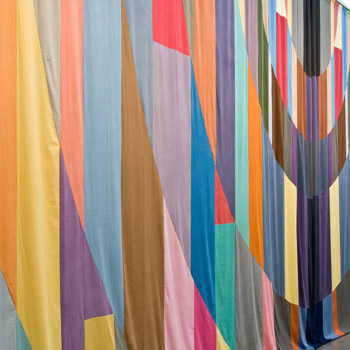
Ulla von Brandenburg, Curtain, 2007, Courtesy Art: Concept, Paris.
Estuaire Nantes
Saint-Nazaire Biennale
Le Sang d'un poète
June 6th - August 30th, 2009
Opening hours: Tuesday - Sunday 1h30pm - 7h30pm
Curators : Adam Budak &
Laurence Gateau
Estuaire Nantes Saint-Nazaire Biennale 2009
Hangar à Bananes, quai des Antilles –
44200 Nantes – France
http://www.fracdespaysdelaloire.com
Le Sang d'un poète
David Altmejd, Cristian Andersen, Christophe Berdaguer & Marie Péjus, Ulla von Brandenburg, Steven Claydon, Jean Cocteau, Keren Cytter, Edith Dekyndt, Spencer Finch, Lothar Hempel, William Hunt, Ann Veronica Janssens, Klara Kristalova, Jim Lambie, Vincent Lamouroux, Victor Man, Mark Manders, Daria Martin, Ursula Mayer, Paul Morrison, Drago Persic, Susan Philipsz, Egill Sæbjörnsson, Markus Schinwald, John Stezaker, Nadim Vardag, Andro Wekua et Guido van der Werve.
"Every poem is a coat of arms. It must be deciphered", with such enigmatic statement the great master and a pioneer of surreal imagination, Jean Cocteau, introduces the viewer to his influential œuvre, "The Blood of a Poet" (1930). The exhibition at the Estuaire takes its point of departure from this mind-blowing vision and aims at enchanting the spectator with its own unique logic of decipherment and unveiling which targets the artistic illusion and art's ability to construct autonomous worlds and (real and metaphoric) sites of escape. Executed as a sequence of voyeuristic tableaux, the exhibition marks, as Cocteau desired, "a descent into oneself, a way of using the mechanism of the dream without sleeping, a crooked candle, often mysteriously blown out, carried about in the night of the human body". The exhibition is a spatial poem, unfolded within the forking paths of a labyrinth of mind and senses, a maze of thought and feelings. Literary, cinematic and theatrical forms are being appropriated and translated into an architectural form that considers concrete physical space as a screen-like matrix to project mainly internal conflicts of a powerful psychological content. At the same time, the exhibition is "written" as an essay on art's identity (its confusion, disorder and possible well-being), the artist's dissolved self and the artist's psychology of a creative process: the very act and a source of creation are fore-grounded and investigated in a series of case studies where private mythologies coalesce with the genuine mechanics of radical imagination and internal transitions. Mysterious like a maze and a Wunderkammer, challenging as a riddle, seemingly psychotic, it is a hallucinogenic attempt at grasping the excess of human emotion and corporeal condition. Dream and daydream are this exhibition's desired locations, where intimacy competes with an exposure, reality with fiction, desire with the mourning, between violence and despair - a spectacular séance of self-portraiture and self-reflexivity, a possibility of art's psychotherapy. As a transgressive and subversive venture into alternative worlds of artistic experience, it oscillates between allegory and fantasy and thus it mirrors the perplexed soul and a contemporary subjectivity, suspended at the edge of ontological doubt, a precarious (artistic) gesture and an aspiration for a mythic dimension.
The exhibition is choreographed as a pantomime where moving image and performative sculpture arranged within the theatrical and architectural setting construct a stage for a spectator to interact with his/her own grammar of gestures and psychic charge. The art works are loosely grouped within eight tentative, thematic and atmospheric shells: flux of sensualities and hybrid voices (William Hunt – Susan Philipsz – Egil Saebjörnsson), daydreaming fantasy & reenacting gestures (Markus Schinwald – Andro Wekua – Lothar Hempel), morphic selves and volatile corporealities (Steven Claydon – Cristian Andersen – David Altmejd), allure of a surface & excess of a fold (Jim Lambie – Ulla von Brandenburg – Paul Morrison), eroticism, a mirror, and a flashback of a soul (Keren Cytter – Ursula Mayer – Daria Martin – Klara Kristalova), machine of illusion & meanders of a mental montage (Nadim Vardag – Drago Persic – Guido van der Werve – Victor Man – John Stezaker), labyrinths of perception & poetic gravity (Edith Dekyndt – Spencer Finch – Ann Veronica Janssens), spatial perversions & interiors of a perplexed mind (Vincent Lamouroux - Bedaguer&Pejus – Mark Manders).
The exhibition is complemented by the film program shown. Le Cinématographe, 12 bis rue des carmélites, 44000 nantes
Séance 1: "Le sang d'un poète", Jean Cocteau, 1930; "L'Etoile de Mer", Man Ray, 1928; "Étude cinématographique sur une arabesque", Germaine Dulac, 1929; "Lumière et ombre", Alfred Sandy, 1928;
Séance 2: "Un chant d'amour", Jean Genet, 1950; "Fireworks", Kenneth Anger, 1947; "Eaux d'Artifice", Kenneth Anger, 1953;
Séance 3: "Meshes of the afternoon", Maya Deren, 1943; "Ritual of Transfigured Time, Maya Deren, 1946; „Witch's Cradle", Maya Deren with Marcel Duchamp, 1943; "8x8", Jean Cocteau & Hans Richter, 1957;
Frac des Pays de la Loire
La Fleuriaye
44470 Carquefou (France)
www.fracdespaysdelaloire.com